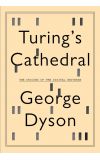
05 Mar 2013 11:30:44
The question of who invented the digital computer is almost as futile, in a way, as asking who built Chartres Cathedral. The answer, in both cases, is "many people". But in the case of the computer, it's at least possible to finger a few of the major suspects. The prime one, of course, is the Cambridge mathematician Alan Turing, who came up with the idea of an abstract machine that turned out to be the theoretical underpinning of all computing devices. But whereas in Britain Turing's insights were harnessed to build machines for code-breaking, across the Atlantic they were constructing machines for more mundane military purposes – such as calculating trajectories for shells and designing nuclear weapons. One of these early machines was constructed at the Institute for Advanced Study at Princeton under the leadership of the great mathematician and polymath John von Neumann. As the child of Freeman Dyson, a famous British physicist who was also at the IAS, George Dyson grew up surrounded by the people who built Von Neumann's machine, and played in the barn where spare parts for the project were stored. So you could say that he was present at the creation.
Many years later, Dyson returned to the scenes of his childhood to exhume the story of how Turing's idea was turned into functioning electronics. His book is a sprawling, digressive, exhilarating account of how Von Neumann's machine was constructed, of the people who built it and of what it was used for. But readers seeking an orderly, linear narrative are doomed to disappointment because ideas are to George Dyson as interesting scents are to puppies, and he can't see a trail without wanting to follow it.
The result is a volume that is part oral history, part intellectual history, part biography and part speculation about the future of the machines that Turing conceptualised and von Neumann and his engineering colleagues brought to life. It's an absorbing read, and a useful reminder of the role that military requirements have played in the evolution of the technology that drives our smartphones. The first application of Von Neumann's machine was in doing the computation needed to ascertain whether a hydrogen bomb was feasible. The calculation ran nonstop for 60 days. So without computers we'd never have had thermonuclear weapons. Or Angry Birds. Now there's a thought.

